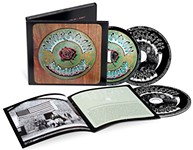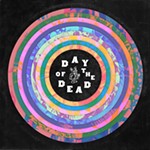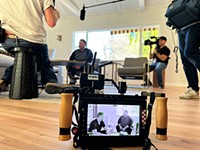Speaking of the Dead
An oral history of the Grateful Dead in Austin
By Kevin Curtin, Fri., July 3, 2015

"Dallas – got a soft machine.
Houston – too close to New Orleans."
Austin receives no such shout-out in "Truckin'," the Grateful Dead's highest-charting single of the Seventies. The psychedelic shamans also toasted Tejas via frequent covers of Marty Robbins' western ballad "El Paso," captured gloriously on 1976's double live LP Steal Your Face, and gave mention to the Lone Star State in live favorite "New Minglewood Blues." Yet in all of Jerry Garcia and company's southwestern lyrical trails, the hippie headquarters of Texas never gets name-checked.
Perhaps our capital city lacks obvious connections to the Grateful Dead, who played here just eight times in 30 years of near-constant touring: 1970, 1971, and 1972 at Austin's Municipal Auditorium, a long-demolished structure where the Palmer now stands; and 1977, 1981, 1982, 1983, and 1985 at horse-racing track Manor Downs.
All were before my time – birth and relocation from Michigan – but there's no shortage of rose-crowned skeletons in my closet. My parents aren't casual fans. They're tie-dyed-in-the-wool Grateful Dead acolytes with closets full of bootleg cassettes. My earliest travel and concert experiences were attending Dead shows, often several in a row, as is customary for GD cultists.
That Deadhead DNA amounts to my primeval memories: mom waking me up and pulling the cotton out of my ears when the band played "The Wheel," the time I became separated from my family and got lost and disoriented in a sea of hippie women in twirling skirts, and seeing the Dead for the last time in Detroit, 1994. I recall Jerry lit up by spotlight while singing "Stella Blue," his white hair and beard making him look like God – except wearing sweatpants. A year later, he was deceased.
As the surviving members of the Grateful Dead cash in on their 50th anniversary with three final concerts in Chicago this Fourth of July weekend, we offer a mostly oral history of their intersection with Austin. Prior to this exercise, all I knew about the GD's local history was a vague recollection about a botched skydiving stunt. After this immersion, I understand the "Scarlet Begonias" lyric: "Once in a while you get shown the light in the strangest of places if you look at it right."
The First Set
Turk Pipkin: 1970 is when I first started hearing the Dead. I was a high school student in West Texas and I would come to Austin to drink like all high schoolers did. I used to go to the only place that served minors: the Pink Lizard, a fabulous, fantastic bar on the Drag about a block from the Hole in the Wall. It was run by a guy named Eddie Burke, who'd call on me to bartend even though I was a teenager. There was lots of trippy music on the jukebox and he always played "Truckin'." That song was ubiquitous in the early Seventies and it put the Dead on the map.
Carl Huff: Everybody in Austin was waiting for the Dead. It was a must-go kinda concert. [Municipal Auditorium] was the biggest venue, and it was filled with the hardcore tie-dye crowd and the traveling Deadhead crews. New Riders of the Purple Sage opened with Garcia on pedal steel. The guy doesn't get enough credit for his phenomenal pedal steel playing. With both bands, he played probably four or five hours. It was the first time I'd gone to a Dead show, and I didn't know what to expect, but it prepared me for every other Grateful Dead show I ever saw: lots of acid, and so long I wasn't sure it was ever going to end.
Eddie Wilson: I'd been out there in Marin [County, Calif.,] trying to stir up some business for the Armadillo. First time I saw Jerry Garcia was at this little club that they jammed in. He was in the kitchen and somebody that I knew told me to go on back. We had the same kind of granny glasses, the same denim shirt with the sleeves rolled up, the same Levis, the same hair that got big out to the side, and both our physiques relaxed towards the waist. We looked so much alike that it looked like I was trying to impersonate him. I walked into the kitchen and he was leaning against a prep table tuning up. He looked up at me and said, "Far out!"
He had a bag of coke bigger than a baby's head and about a 14-inch screwdriver that was an inch wide at the end. He put it forward and the pile at the end of that thing was as large as my whole nose. So I did the best I could to levitate it off the screwdriver.
The day the Grateful Dead made its third appearance at Municipal Auditorium on Nov. 22, 1972, Wilson received a call from Sam Cutler, a former Rolling Stones tour manager who'd been demonized after that band's deadly Altamont Speedway fiasco and later managed the Dead. Cutler asked the Armadillo to feed the band, and the venue's hippie kitchen served them tenderloins with bowls of joints as table centerpieces.
"During dinner, Garcia looked up at the place and said, 'I'd like to play here,'" recalls Wilson. "I said, 'Okay, I can arrange that. When?' He said, 'We're not doing anything tomorrow.' So I asked, 'What time?' and he kind of got short. He didn't like promising details."
The Dead were on fire in 1972, having logged a monumental European tour. Although vocalist and organist Ron "Pigpen" McKernan had recently bowed out with fatal health problems, the band played an energetic set that included an 18-minute version of Bob Weir masterpiece "The Other One."
"After the show, I was standing there with Leon Russell when Jerry walked in," continues Wilson. "He goes, 'We're gonna jam tomorrow at the Armadillo; why don't you come over?' Leon says, 'Fine, what time?' And Garcia looks over at me and I say, 'How about 3 o'clock?'"
The club owner placed one call to a local radio station, announcing that the 'Dillo would be open on Thanksgiving and some friends would be playing.
"The next day, the doors open and people are filtering in, wondering what's going on," says Wilson. "Garcia wouldn't go on. He said, 'Lets just wait till Doug [Sahm] gets here. He's the bandleader; he knows a thousand songs.' And he did exactly that."
The impromptu band, featuring Garcia again on pedal steel, Sahm, Russell, Dead bassist Phil Lesh, and several backing musicians, rallied through 29 covers by artists including Charley Pride, Roger Miller, Hank Williams, and Bob Dylan.
"It swelled into a real nice crowd, probably about 1,000 people," smiles Wilson. "Leon Russell later told me, 'It may have been my worst performance ever.' He's not a jam musician. He's an arranged guy."
The Second Set
After their trio of Downtown shows in the early Seventies, the GD found a new home base in Travis County at Manor Downs, a world-class quarter horse training facility just northeast of Austin that was owned by a friend of the group, Frances Carr. Its unofficial slogan was "Horse racing and rock & roll."
Woody Roberts: The group at Manor Downs were part of the Marin Spin. Frances and Sam Cutler, Libby Jones, and Bill Seal all worked together at a company called Out of Town Tours after Sam quit managing the Dead. They were in charge of road tours and had booked the Dead shows at the Municipal Auditorium. So when Sam and Frances opened the Downs, they brought in Gary Hart, road manager for New Riders. They were all part of the Dead extended family. Chesley [Millikin, Stevie Ray Vaughan's manager] was part of the whole Marin scene. Ray Slade would hang too. He was one of [Ken Kesey's] Merry Pranksters. Frances' brother Loose Bruce Baxter was out there too. They all moved back to Texas from California and that was the connection. They were all at Manor Downs.
Edi Johnson: Frances was a friend of the Grateful Dead. They did hang out there because we had houses at Manor Downs they could stay in. Most groups would come play and stay at a hotel, but they actually stayed in one of the houses. It wasn't so much like, "This is the band and we know them." They were friends! The fact that they were friends with Frances was probably the reason they booked shows at Manor Downs.
Dave "Grateful Dave" Moynihan: The scene at Manor Downs Dead shows was a combination of bikers, hippies, cowboys, and freaks, and everybody got along. That was what Willie Nelson really did to Austin. Before, the rednecks would see someone with long hair and want to kick the shit out of them. But when Willie started playing at the Armadillo, these people were like, "Hey, we can get along!"
My favorite memory is from '82, walking into a Manor Downs show. There was a fellow with an artist easel set up and he had sheets of paper that were a dragon – maybe 100 or 200 LSD hits on a sheet. And he was selling these sheets like hotcakes – whole sheets, pieces, strips, singles, whatever you wanted. There were folks lined up to enjoy his art and I remember a guy stating, "I'm waiting for those red eyes of the dragon."
Turk Pipkin: Everyone was doing mescaline and acid. The people who weren't doing drugs at those shows were doing mushrooms. We had a couple of wet springs, and you could go to Bastrop and go out in a rancher's field with trash bags and completely fill a trunk with mushrooms in half an hour. And yeah, they tasted like cow shit, but so what? Austin was a perfect match for the Dead because the crowds were really high and mellow in those days.
The Chronicle's Margaret Moser reviewed the Dead's 1982 Manor Downs concert for her "In One Ear" column:
"Just the process of going to the show was an exercise in reality. Along the road I felt like I was going to Woodstock or something, but without the alienation I usually feel when someone I know sticks their head in my face and bellows, 'Smile man!' Tents were pitched, Indian prints were stretched between VW vans (no recreational vehicles here), a few hibachis fired up here and there, long-haired women in ankle-length skirts herding around naked little children.
"To the left and right hawkers with their wares – T-shirts in neo-Dead designs, mostly poorly executed, gimme caps, bagels and cream cheese, you name it. It was difficult at points to tell whether I was at a concert, circus, or convention. Maybe it was a little of all three."
Garcia began that show by forgetting most of the lyrics to opener "Alabama Getaway" but got over the mumbles and performed a clutch second set.

Drums/Space
Woody Roberts: I thought their coolest show at Manor Downs was the Fourth of July [1981]. Frances had gone ahead and sprung for a first-class fireworks display. The Dead took their break and came back to start their jam. When it got to drums, they set the fireworks off. There are Bill Kreutzmann and Mickey Hart, and they're playing with the fireworks – boom boom – and they'd beat along on the drums – boom, boom, boom. It was a trip.
Jay Trachtenberg: In 1983 I interviewed Mickey Hart. I called their publicist, Dennis McNally, and said, "The Dead are coming to Austin. I'd like to do an interview with Mickey Hart." He said, "Mickey's not doing interviews." I said, "I'd like to talk to him about the Diga Rhythm Band [Hart's world music side project]."
He said, "He'll do the interview." Just like that.
We were supposed to meet him backstage at 5 or 6pm, whatever time it was. I get there with my friend and we drop a tab of acid, thinking I'd do the interview and then come up afterwards. There wasn't anything backstage at Manor Downs. I just went up and said, "I'm supposed to do this interview." I didn't have any credentials. They could have easily said, "Fuck you, you're not getting back here." Somehow we got through two or three of these – no name at the door, nothing.
So we're waiting back there and coming up and all of a sudden from the west, on a back road, there's a limousine flying up in all this dust. Two doors fly open, Jerry Garcia gets out of one door and Mickey Hart gets out the other. I went up to Mickey and told him Dennis had set up the interview. He says, "Okay, let me get settled."
We went back to his dressing room and the acid was really starting to come on and he's got this little practice pad and he's getting zoned out on playing. I ask him some nebulous thing about the Dead and he kind of blows it off. Then I say, "So tell me about the Diga Rhythm Band," and he engaged. Once I zeroed in on him, I didn't feel like I was tripping my brains out. We sat there and talked for 20 or 30 minutes and he went through the whole thing about world music and then he said, "This is the last night of the tour. This is really gonna be a loose kind of show."
We finish the interview and I step out of the trailer, and my head just kind of explodes! I'm on, plus the rush of having just spoken to him. Sure enough, it was one of the spaciest shows. They opened the second set with a 25-minute "Scarlet Begonias/Fire on the Mountain," and the middle of that was the Diga Rhythm Band song "Happiness Is Drumming." And I'm thinking, "He's playing it for me! We talked about it and now they're playing it!"
Later I found out they'd played that same transition earlier on the tour.
Finale
A steady, focused performance at Manor Downs in August 1985, in which the band encored with a stunning Garcia-sung version of Dylan's "She Belongs to Me" swelling into a rave-up of "One More Saturday Night" (it was actually a Saturday), turned out to be the Dead's final local jam.
Woody Roberts: The Dead didn't really like to play Texas. It was so spread out here. They made their money up and down the East and West Coasts. They stopped coming to Austin because the Downs stopped having music in 1986. It shut down and reopened as a pari-mutuel [off-track gambling].
Manor Downs had been a soft place to land for the Dead, but without that friendly connection, Austin got crossed off their list. In 2009, Dead co-founder Bill Kreutzmann joined forces with then-local guitarist Malcolm "Papa Mali" Welbourne, Reed Mathis of Tea Leaf Green on bass, and Austin pianist/trombonist Matt Hubbard in the funky voodoo rock outfit 7 Walkers (revisit "Swampadelic," Nov. 26, 2010).
Matt Hubbard: Bill said, "Hey, Robert Hunter has some lyrics." He's of course the lyricist for the Grateful Dead. And one of the songs was called "7 Walkers." We were sitting around and Bill says, "Let's call the band 7 Walkers." We recorded the album in Austin at a studio called the Nest. We did a solid week with a 24-track, two-inch tape machine. Some days we recorded for 12 straight hours, just jamming. We'd already demoed some of the songs at Willie Nelson's place in Luck. One of the songs, "King Cotton Blues," I got Willie to perform on.
When you play with Bill, anything is possible. He likes to say that every beat is the one. Whenever he plays, it makes people dance. As the Dead's drummer, he drove a lot of their long jams, and he's played for more people live than any drummer in the history of the world, which is mind blowing. He's a very happy drummer and music is sacred to him.
Encore
What about the skydiving stunt gone wrong?
Margaret Moser: Skydivers? I vaguely recall.
Woody Roberts: I don't remember exactly what happened. There was supposed to be skydivers and it seems like something went wrong with one of the dives, but I can't recall.
Turk Pipkin: I heard that story for years. I'm not sure now if I remember it happening, or if I've heard the story so many times that I think I do.
Henry Gonzalez: They'd already opened the gates, so people were in there. They put a big cross in front of the stage and here comes the plane. One of the divers didn't show up because he was sick, so they threw out a dummy in a skydiver suit. And then the other two guys jumped out. They parachuted out, but the dummy went straight down, right to the cross. I was a bouncer that night and I remember seeing that guy falling and everyone going, "Ahhhhhhhhhh!"
They freaked out! I mean, how many people do you think were under the influence?
Fare Thee Well: Live from Soldier Field, a live simulcast from Chicago on the day of each show, plays in three local theatres, Fri.-Sun., July 3-5, 7pm, and runs approximately five hours: Metropolitan 14 (901 Little Texas Lane), Cinemark Southpark Meadows (9900 S. I-35), Cinemark Hill Country Galleria (12812 Hill Country Blvd., Bee Cave). More info at: www.fathomevents.com/event/fare-thee-well.









